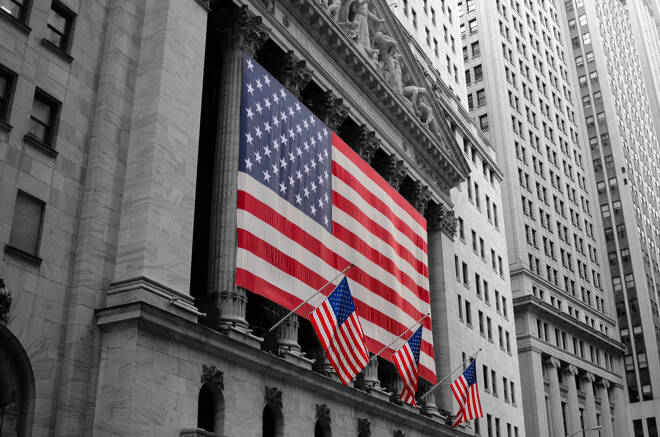Advertisement
Advertisement
Brace Yourself For Another Wild Month In Stock Markets
By:
Stock indexes remain on a wild ride! Monday brings the end of the month and some are saying it will be the worst January ever for the stock market.
For the year, the Dow is down -6%, the S&P 500 is down just over -9%, and the Nasdaq has lost -14.7%. The previous record-holder is January 2009, an ugly moment for the economy, when the stock market fell -8.6%. In addition, the VIX – aka the CBOE Volatility Index – has actually dropped back to around 31 after topping 37 earlier this week, its highest point since November 2020.
Keep in mind, the index isn’t registering anywhere close to levels reached during other periods of “extreme” volatility. For example, the index, which is measured between zero and 100, hit its highest point of almost 83 during the financial crisis in 2008. Its most extreme point during the pandemic was around 66 in March 2020. So, by comparison, this week’s volatility has been rather mild.
Federal Reserve
Some insiders equate the wild swings in stock prices to investors, particularly “big money,” trying to establish a new baseline for stock valuations minus the Fed’s easy money policies that have driven a massive amount of cash into markets since the pandemic began in 2020.
At its height, the Fed was pumping as much as +$120 billion per month into the system via its asset purchase program, ballooning its balance sheet to now nearly $9 trillion.
At the same time, the Fed has held its benchmark rate at near-zero and, before that, hadn’t even attempted to raise rates since 2018, and then only briefly. The last full-cycle of rate hikes was 2015. What’s more, investors haven’t really had to factor for inflation since the early 90s and it hasn’t been this high since the 80s.
Bottom line, whatever the new “normal” ends up looking like, it will be dramatically different from the pre-pandemic investing landscape. I’ve heard several large stock traders saying it seems to be the return of Alpha instead of the race to levered Beta. I hear others on Wall Street referencing it to a bit of league recreational youth baseball team where everybody now gets an award simply for participation, but then kids run into a rude awakening when performance really starts to matter.
It feels like we are there in the stock market; every business that was coming into the market was simply being rewarded with participation points, now people are starting to keep a real scorebook and counting the strikeouts and runs scored.
Economy still roars
The good news is that the U.S. economy continues to roar. Historically, a combination of moderate inflation and moderate interest rates has led to some of the biggest boom times for U.S. Last week, the Commerce Department said Q4 Gross Domestic Product (GDP) grew at an annualized rate of +6.9%, stronger than Q3’s +2.3% and well above Wall Street expectations of around +5.7% growth.
Consumer spending climbed at a +3.3% annual pace led by a +4.7% increase in services spending. But the real stand out was private investment which rocketed +32% higher, boosted by a surge in business inventories as companies stocked up to meet higher customer demand. Rising inventories, in fact, contributed nearly +5% to Q4 GDP growth.
On the one hand, the inventory build is positive because it indicates an easing of supply chain dislocations that should in turn help with inflation pressures. On the other hand, many economists note that the big boost from retailer and wholesaler restocking is not likely to be repeated.
Companies will also likely start to unwind at least some of that inventory in the quarters ahead, which could drag overall 2022 GDP, especially if consumer spending also drops off. And investors are more closely tracking consumer behavior as inflation continues to rise.
With consumer spending accounting for about 70% of the U.S. economy, any signs that belts are tightening or moods are getting overly pessimistic will likely set off some alarm bells.
Data to watch
Turning to next week, it will be another busy one for both key economic data as well as earnings. The main economic data highlight will be the January Employment Situation on Friday. Other key data includes ISM Manufacturing, Construction Spending, and the JOLTS report on Tuesday; ADP’s private payrolls report on Wednesday; Productivity & Costs, Factory Orders, and the ISM Non-Manufacturing Index on Thursday.
Earnings wise, results are due from NXP Semiconductor and Trane on Monday; Advanced Micro Devices, Alphabet, Amgen, Chubb, Electronic Arts, Exxon, General Motors, Gilead Sciences, Match Group, PayPal, Sirius XM, Starbucks, and UPS on Tuesday; AbbVie, Aflac, Allstate, Boston Scientific, CNH, Corteva, D.R. Horton, Ferrari, Humana, Johnson Controls, Meta (Facebook), MetLife, Novartis, Novo Nordisk, Qualcomm, Siemens, Thermo Fisher, TMobile, and Waste Management on Wednesday; Activision Blizzard, Amazon, Biogen, Carlyle Group, Check Point, Cigna, Clorox, ConocoPhillips, Deckers Outdoors, Eli Lilly, Estee Lauder, Ford, Hanesbrands, Hershey, Honeywell, Ingredion, Merck, Pinterest, Quest Diagnostics, Royal Dutch Shell, Snap, SnapOn, Wynn Resorts, and Xylem on Thursday; and BristolMyersSquibb, CBOE, Phillips 66, Regeneron, and Sanofi on Friday.
Bottom line, brace for another huge week of extreme volatility.
About the Author
Inna Rosputniacontributor
Inna Rosputnia has been involved in the markets since 2009 and is the founder of https://managed-accounts-ir.com/
Advertisement
